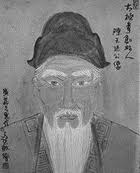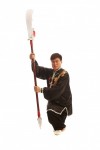2.a.-what-is-taijiquan Section
What is Taijiquan?
written by Nick Gudge
T'ai Chi Ch'uan or taijiquan to give it it’s Chinese name in pinyin. (more commonly known as tai ch i or taiji) is the name given to a Chinese internal martial art. Its history can be traced back several hundred years and this is briefly outlined in the next article. Its fundamental principles have been espoused in Chinese culture for more than a thousand years, taking distinct form with Chen Wang Ting in the latter part of the 17th century.
i or taiji) is the name given to a Chinese internal martial art. Its history can be traced back several hundred years and this is briefly outlined in the next article. Its fundamental principles have been espoused in Chinese culture for more than a thousand years, taking distinct form with Chen Wang Ting in the latter part of the 17th century.
It has evolved in the second half of the 20th Century into a widely practised and recognised form of exercise. In its original state it was a highly skilled and powerful martial art and its highest practitioners were considered peerless fighters. It is still practised this way in a small number of schools.
One of the things which separated internal from external fighters was that despite increases in age, elderly practitioner’s power and skill levels were scarcely diminished. Power increases into their 50’s and 60’s were usual: good physical health and capability in the latter stages of their lives was often remarkable. The basis for generating this power was observed also to be an excellent basis for maintaining good physical and mental health.
 Some taijiquan forms, like the beginner’s one presented in this school, have evolved to focus primarily on training taijiquan principles for health and relaxation rather than fighting. In this respect they are more forms of Chi Kung (Qigong) than fighting forms.
Some taijiquan forms, like the beginner’s one presented in this school, have evolved to focus primarily on training taijiquan principles for health and relaxation rather than fighting. In this respect they are more forms of Chi Kung (Qigong) than fighting forms.
All taijiquan forms are in part vehicles for the training of power issuing and internal strength based fighting applications. In some forms this is still primary e.g the Chen Style Cannon Fist form (Pao Chui). Their concern is not with health at all but with the development of fighting skills. All types and mixtures of internal forms should use the same type of movement and body connection. Their practice should assist in the development of these skills.
There are taiji weapons forms, sword, spear, etc. all of which also are used to continue the development of these skills and increase the conditioning of the body to allow for the propagation and release of greater power and greater sensitivity. Naturally they also involve the martial techniques pertinent to that weapon.
On the outside, most taiji forms appear to be a slow-moving meditative exercise; graceful, tranquil and in many respects this is what they are. This whole body, internal form of movement exercises the mind as much as the body and is a basis for retraining how the whole body and mind are used. The type of power or strength can be called nei jin (internal strength) and the skills developed are known as internal skills. Learning to relax the body, quieten and focus the mind, loosening the joints are all pre-requisites for this type of strength. Much of taiji training is spent on learning these skills, both directly and indirectly.
While these skills are difficult to access directly for the beginner it is useful to state the two major skills a beginner might want to keep in mind:
1. Keep the body relaxed and loose (fang song) without becoming limp
2. Stretch the body lightly to learn, within this loose, relaxed framework, to become strong using Peng Jin, the primary skill or energy of taijiquan.
When you have an understanding of these two, and an ability to use them consistently, you may realistically then not consider yourself a beginner. Remember, the choreography of any form is merely a framework, (a workshop if you will,) within which to study taijiquan.
Nick Gudge teaches taijiquan (tai chi) classes in Limerick. For details of his next beginners' classes see here.


